
202
(except for designated ports) should receive BPDUs at regular intervals.
Any port that age out STP information (provided in the last BPDU)
becomes the designated port for the attached LAN. If it is a root port, a
new root port is selected from among the Switch ports attached to the
network.
Hello Time
This is the time interval in seconds between BPDU (Bridge Protocol Data
Units) configuration message generations by the root switch.
Forward Delay
This is the maximum time (in seconds) the Switch will wait before
changing states. This delay is required because every switch must receive
information about topology changes before it starts to forward frames. In
addition, each port needs time to listen for conflicting information that
would make it return to a blocking state; otherwise, temporary data loops
might result.
Path Cost
Path cost is the cost of transmitting a frame on to a LAN through that
port. It is recommended to assign this value according to the speed of the
bridge. The slower the media, the higher the cost.
Root Cost
This is the number of the port on the Switch through which this Switch
must communicate with the root of the Spanning Tree.
6.14.4
MSTP
MSTP (IEEE 802.1S Multiple STP), which uses RSTP for rapid convergence, enables VLANs
to be grouped into a spanning-tree instance, with each instance having a spanning-tree topology
independent of other spanning-tree instances. This architecture provides multiple forwarding
paths for data traffic, enables load balancing, and reduces the number of spanning-tree instances
required to support a large number of VLANs.
Multiple Spanning-Tree Regions
For switches to participate in multiple spanning-tree (MST) instances, you must consistently
configure the switches with the same MST configuration information. A collection of
interconnected switches that have the same MST configuration comprises an MST region. The
MST configuration determines to which MST region each switch belongs. The configuration
includes the name of the region, the revision number, and the MST instance-to-VLAN
assignment map. You configure the switch for a region by using the spanning-tree mst
configuration global configuration command, after which the switch enters the MST
configuration mode. From this mode, you can map VLANs to an MST instance by using the
instance MST configuration command, specify the region name by using the name MST
configuration command, and set the revision number by using the revision MST configuration
command.
A region can have one member or multiple members with the same MST configuration; each
member must be capable of processing RSTP BPDUs. There is no limit to the number of MST
regions in a network, but each region can support up to 16 spanning-tree instances. You can
assign a VLAN to only one spanning-tree instance at a time.
Boundary Ports
A boundary port is a port that connects an MST region to a single spanning-tree region running
RSTP, or to a single spanning-tree region running 802.1D, or to another MST region with a
Summary of Contents for NGI-M08C4-L2
Page 1: ......
Page 285: ...285 9 2 2 Web Configurations...
















































